On The Toyota Corolla Cross, Hyundai Santa Cruz, and VW Subscriptions
How to charge an autonomous vehicle. Toyota adds a new crossover. VW gets into the subscription business. Hyundai goes Santa Cruz. And more.
Robotic/Electric/Autonomous
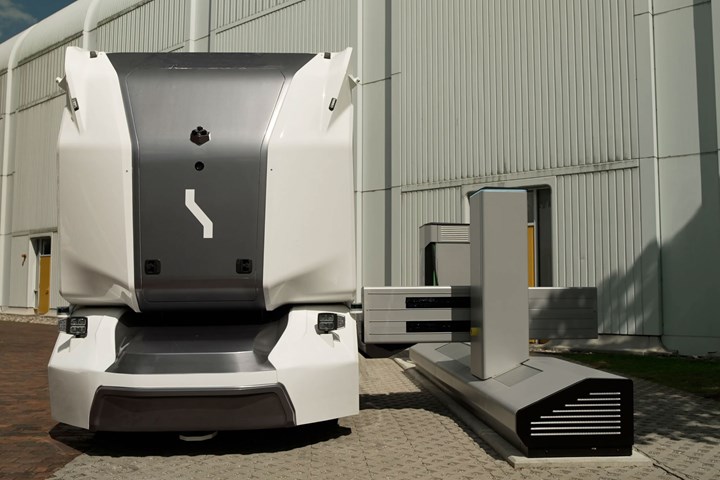
Einride autonomous, electric truck being robotically charged. (Image: Siemens)
If you travel with your computer (including charger) and other electronic devices, you know that wires and things using them are surprisingly heavy.
Scale up the wire to the size of a cable and the mass is increased proportionately.
To charge light vehicles: Not a big deal.
But to charge a Big Rig: the weight is undoubtedly a big deal.
Taking on the Truck
Siemens—which has deployed some 75,000 chargers in the U.S., ranging from 4 kW to 600 kW (for bus lines)—recognizing the challenge of hoisting the cables that would be necessary for Class 8 truck charging, has developed the Siemens Autonomous Charging System.
It has developed a robot that handles the cable-handling task for trucks.
It is currently testing out the system with Einride AB, the company that is producing electric and autonomous freight-hauling vehicles.
Robotic-enabled fast-charging for autonomous vehicles.
A tech trifecta.
///
Corolla Cross Comments
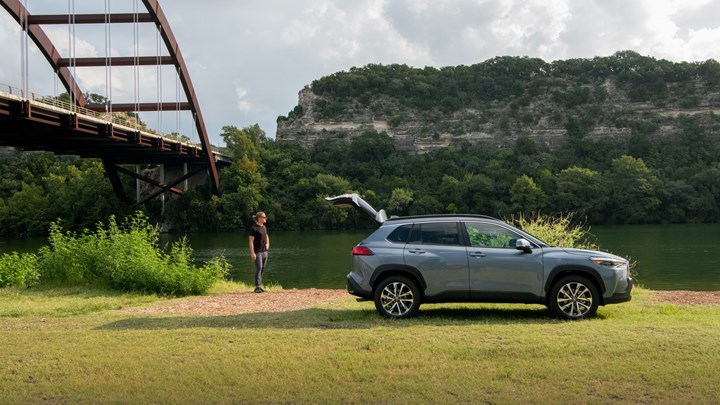
A small crossover targeted at late-stage Millennials, among others, the Corolla Cross. (Image: Toyota)
Although the Camry continues to lead car sales in the U.S. year after year to the degree that it is almost a certainty (i.e., for those keeping track, it became the #1 selling car in 1997 to 2000, was outsold by the Accord in 2001, but regained the crown in 2002 and has kept it firmly in place since), it is actually no longer the best-selling Toyota.
In 2020 (yes, a bizarre year for vehicle sales, but we’ll be making an apples-to-apples comparison) there were 294,348 Camrys sold. A respectable number. An industry-leading number.
But a number dwarfed by sales of the RAV4 in 2020: 430,387 vehicles.
And this isn’t some sort of anomaly.
In 2019—a “normal” year”--Toyota sold 336,978 Camrys and 448,071 RAV4s.
One of the segments of the market that is growing is the entry crossover. Toyota does have a subcompact, the C-HR. It, by the aforementioned numbers, is not doing great. In 2020 there were 42,936 C-HRs sold. In 2019 it was 48,930.
But one of the things about the C-HR is that it isn’t available with AWD.
So Toyota has decided that a vehicle that could slot into this crossover space between the C-HR and the RAV4 would be a solid performer in the market.
Enter the Corolla Cross.
The 2022 Corolla Cross is based on the Corolla sedan platform but is reimagined as a small crossover.
Although it is positioned between the C-HR and the RAV4, it shares the same platform with the C-HR, TNGA-C. So dimensionally there is similarity:
- Wheelbase: Corolla Cross, 103.9 inches C-HR, 103.9 inches
- Length: Corolla Cross: 175.6 inches C-HR: 171.2 inches
- Width: Corolla Cross: 71.9 inches C-HR: 70.7 inches
- Height: Corolla Cross: 63.4 inches C-HR: 61.6 inches
Here’s a dimension that seems somewhat odd.
“C-HR” is an acronym for “Coupe High Rider.” Yet the ground clearance of the C-HR is 5.9 inches.
It is 8.1 inches for the Corolla Cross.
It is a higher rider.
Corolla Cross Quickly
- Front- or all-wheel drive
- AWD system sends a variable amount of torque, from 10 to 50%, to the rear wheels as needed
- Three trims
- 2.0-liter four-cylinder engine producing 169 hp and 150 lb-ft of torque
- “Direct-Shift” CVT (there is a real first gear, which accounts for the “Direct Shift”)
- 26.5 cubic feet of cargo behind the second row (to put that in perspective: the C-HR offers 19 cubic feet behind the second row)
- 1,500-lb towing capacity
- Apple CarPlay, Android Auto and Amazon Alexa standard
- Seven- or eight-inch touchscreen (base model 7 inches)
- Standard Toyota Safety Sense 2.0 (Pre-Collision System with Pedestrian and Cyclist Detection, Lane Departure Alert with Steering Assist, Lane Tracing Assist, Road Sign Assist, Full-Speed Range Dynamic Radar Cruise Control, Automatic High Beams)
Making It
The Corolla Cross is being produced at the all-new, $2.3-billion Mazda Toyota Manufacturing plant in Huntsville, Alabama. When running at full capacity—which is 300,000 units per year—there will be as many as 150,000 Corolla Crosses produced there. (Mazda gets the other half of capacity.)
///
Who Designed This?
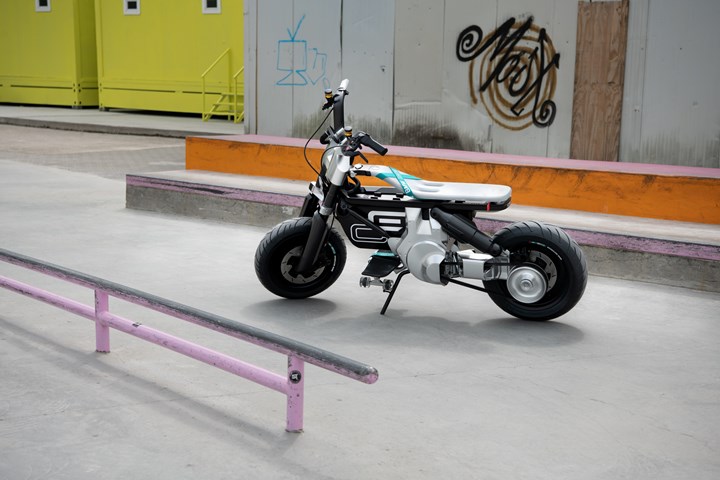
Who designed this? (Image: Name of company in copy below)
The photo above is the “Concept CE 02.”3
Yes, it is a concept vehicle.
But here’s a quiz:
What company designed this electric vehicle concept?
Dum-dum-dum-dum, dum dum dum, dum dum dum dum dum,da da-ta da. . . .
BMW.
Yes, the company that makes some of the most robust, Teutonic two-wheelers on the world’s roads and things that are somewhat like roads has designed that.
Edgar Heinrich, Head of Design BMW Motorrad:
“At first glance, there is little about the BMW Motorrad Concept CE 02 that is typically BMW Motorrad”—which could be the understatement of the year—“—it’s something completely new. . . . The Concept CE 02 features new proportions and modern forms of single-track mobility in an urban environment. In addition, we wanted to achieve a level of design innovation that we have not had before at this level. Straightforward use was important, but above all the emotional component was crucial, as well as riding fun.”
Metrics
It has 15-inch disc-like wheels; a seat height of 28.7 inches; a weight of 264.5 pounds; a motor output of 11 kW; a top speed of 56 mph; and a range of 56 miles.
Market?
Alexander Buckan, Head of Vehicle Design BMW Motorrad:
“You love it because it’s always there for you and it just works – even if you occasionally don't treat it as carefully as you might. And there are stickers, tapes and other forms of customization that make it quite clear to everyone that it belongs to you. It embodies youthful freedom and a carefree spirit – rather like a skateboard on two wheels.”
With that, you can figure out the intended customer.
///
VW Metric for Mobility
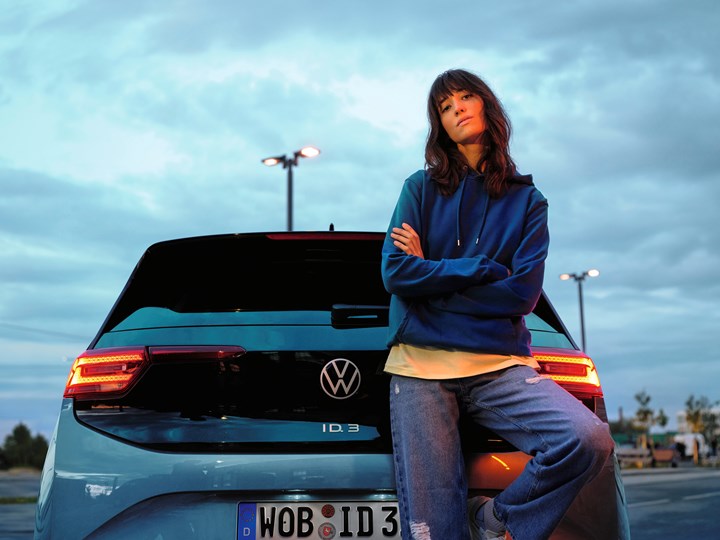
She may not want to own a car. (Image: VW)
A lot of what have long been known as “car companies” are now referring to themselves as “mobility companies.”
Which presumably means going beyond manufacturing vehicles. This could mean offering alternative types of vehicles. Or not selling vehicles.
Volkswagen brand, which is undertaking what it calls its “ACCELERATE” strategy, which is about business transformation and digitalization of its activities, has started a subscription service for its customers in Germany.
About Subs
Vehicle subscription services from OEMs is not a new phenomenon. There is Care by Volvo, which provides everything from insurance to maintenance for a monthly fee starting at $675 per month with the possibility of canceling the subscription after the fifth payment. There is BOOK by Cadillac, which, well, is on hiatus.
Let’s face it: this subscription model is something that is not necessarily in an OEM’s wheelhouse.
The VW Approach
Volkswagen has established AutoAbo, its monthly subscription service. It will offer its ID.3 and ID.4 electric vehicles.*
As Klaus Zellmer, Board Member for Sales and Marketing at Volkswagen, put it, “A growing number of people don’t want to own a vehicle permanently, but would like the exclusive use of one for a defined period.”
So its defined period is either a three- or six-month minimum, then termination whenever after.
20?
But here’s the surprising thing:
Zellmer: “We estimate that, by 2030, around 20 percent of our revenue could come from subscriptions and other short-term mobility offerings.”
Which stopped us in our proverbial tracks.
Twenty percent?
So we contacted VW Germany and asked if Zellmer was saying what he seems to be saying.
And we learned:
“Correct. This means 20% of the revenue of the Volkswagen Passenger Brand.”
Twenty percent!
*These are what is described as “nearly-new used cars.” One of the issues of OEMs and vehicle subscription services is handling the vehicles after they’re turned back in. This is one of the reasons why Volvo is working hard at modularity. It has an objective of making it so that an off-subscription vehicle can have new elements added and old ones removed such that it isn’t a “used car” in the classic sense but something that is sufficiently different.
///
About the Hyundai Santa Cruz
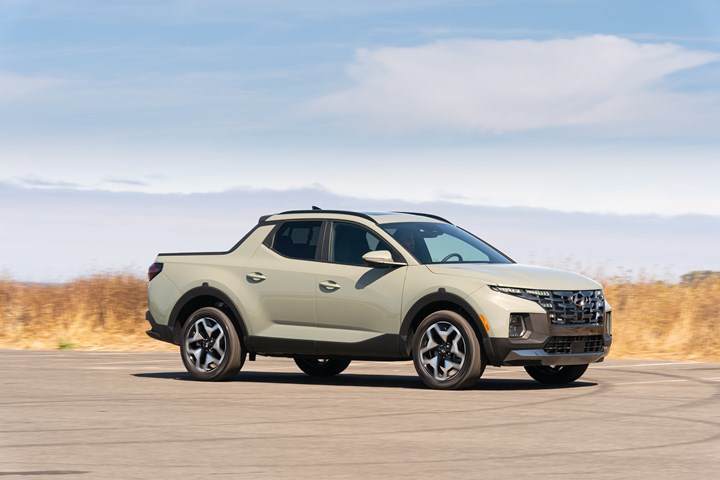
Hyundai Santa Cruz: This is not a truck. (Image: Hyundai)
Melvyn Bautista, who is with Hyundai Motor North America Product Planning, wants to make something clear:
- ’22 Hyundai Santa Cruz, Hyundai’s first North American-specific vehicle, conceived, designed, engineered and manufactured in the United States, is NOT a midsize pickup
Bautista acknowledges that the Santa Cruz, which is based on the Tucson SUV platform (and which is built at Hyundai Motor Manufacturing Alabama along with the Tucson—as well as the Santa Fe crossover and Sonata and Elantra sedans, indicating that they’re busy down in Montgomery), has a box on the back (52.1 inches long; 53.9 inches wide max, and 42.7 inches wide between wheel houses; 19.2 inches high) that can handle a maximum payload of 1,753 pounds which makes it “look” like a truck.
What’s more, the Santa Cruz can tow up to 5,000 pounds (when it has AWD and the 281-hp/311 lb-ft of torque turbocharged 2.5-liter engine), and towing is something that is often characteristic of pickup trucks.
But how they see the Santa Cruz is as something that crossover owners, not traditional pickup truck owners, would be most interested in.
SAV
They designate it as a “sport adventure vehicle.”
A name that won’t catch on.
Bautista does show a Venn diagram with the sets being Sub-Compact SUV and Midsize Trucks, with the intersecting elements for the Santa Cruz being:
- Design
- Utility
- Interior Space
- Comfort
- Efficiency
- Innovative
So to take them individually:
- Design: Again, Hyundai design has created something that looks contemporary and capable, with the last being predicated more on the bed in the back than what they consider a “robust bumper” (in the world of trucks it isn’t).
- Utility: We’ve seen the specs.
- Interior Space: You’d think that you’re riding in something like a Tucson. The passenger interior volume and the total interior volume are the same (101.8-cubic feet) because the cargo volume is all in the back
- Comfort: See previous
- Efficiency: It is 195.7 inches long, 75 inches wide, 66.7 inches high, and has a 118.3-inch wheelbase. An efficient package. The AWD version with a 2.5-liter non-turbo engine, which provides 191 hp and 181 lb-ft of torque, returns 21 city/27 highway/23 combined miles per gallon. That’s efficient.
- Innovative: The vehicle is chock full of advanced safety and infotainment tech which is innovative in and of itself.
As for the items on the Venn that are in the Midsize Truck category that don’t fall into the Santa Cruz space:
- Body-on-Frame. Well, there is the Honda Ridgeline. . .
- Poor MPG. The forthcoming Maverick, which is unapologetically a truck, is possibly getting 40 mpg city (it is a hybrid)
- High MSRP. Maverick starts at $19,995 (less than the Santa Cruz, which has a starting MSRP of $23,990)
- Basic design. There is no question that the designers at the Hyundai Design Center in Irvine, CA, have out-styled any truck out there
About the Bed
It is glass-fiber reinforced polyester. The sheet molding compound was selected because it doesn’t dent, scratch or corrode. It is also molded so that there is underbed storage with drain plugs because Santa Cruz buyers are likely to want a place to throw their muddy hiking boots after they’ve been out adventuring—or to let the water drain out from the melted ice from the tailgating.
///
Field to Ford

Doug Field joins Ford from Apple—having previously been with Tesla and Segway (during its heyday). (Image: Ford)
The headlines related to Ford hiring Doug Field as its chief advanced technology and embedded systems officer (quite a title, that) note that Ford got him from Apple. Which is true. Field’s most recent position at Apple was as vice president, Special Projects.
That “Special Projects” is taken as code for the “Apple Car.”
Tesla, Too
But what is more interesting about Field’s background is that he had had engineering and development positions at Tesla and at Segway before that.
His Segway experience was when the company had launched and developed its self-balancing personal transporter under the direction of Dean Kamen, who was once the visionary genius in the transportation and other fields.
Then at Tesla he was the senior vice president, Engineering.
During that stint I had had the opportunity to talk with Field at a dinner, where he was to accept an award for Tesla technology.
It became clear that Field certainly respected the ideas of Elon Musk, who has become even more the visionary genius in the transportation and other fields.
That conversation came to mind when I read a quote in the release from Ford announcing Field’s appointment.
The quote from Field:
“There is a set of common principles that unite companies building world-changing products. A fundamentals approach to engineering, grounded in physics. A relentless pursuit of excellence in everything they do. An integrated way of thinking about all the disciplines that come together when developing new products. And a sensitivity to design, and why customers fall in love with products and brands. I am lucky enough to have worked in teams and companies that embody these principles, and I know they will be a part of building great products and experiences at Ford.”
It was the “grounded in physics” phrase that reminded me of my talk with Field.
Then he had made the point that whereas many people in the auto industry take things as a given because that’s the way they’ve long been, Musk looked at situations and took them to first principles: Why is something the way it is, and is it possible that it could be otherwise?
In a sense, it is somewhat like the “Five Whys” of the Toyota Production System.
Of course, a difference is that whereas Toyota is generally conservative in implementation, Musk has proven himself to be otherwise.
A Coincidence
The dinner and award ceremony were held at the Automotive Hall of Fame in Dearborn. That’s literally across the street from the Ford Product Development complex.
Field, whose mandate includes the Ford Embedded Software and Hardware organization, will be working with Hau Thai-Tang, who, among other things, oversees Ford product development.
Small world.
RELATED CONTENT
-
GM Develops a New Electrical Platform
GM engineers create a better electrical architecture that can handle the ever-increasing needs of vehicle systems
-
On Fuel Cells, Battery Enclosures, and Lucid Air
A skateboard for fuel cells, building a better battery enclosure, what ADAS does, a big engine for boats, the curious case of lean production, what drivers think, and why Lucid is remarkable
-
Things to Know About Cam Grinding
By James Gaffney, Product Engineer, Precision Grinding and Patrick D. Redington, Manager, Precision Grinding Business Unit, Norton Company (Worcester, MA)


.jpg;width=70;height=70;mode=crop)






